Ellen and Jim Have a Blog, Too
We are two part-time academics. Ellen teaches in the English department and Jim in the IT program at George Mason University.


_Pallisers_ 4:8: In the thick of life, politics & marriage: Phineas & Laura (Thematic summary) (1) · 16 February 08
Dear Harriet,
Another essay in the form of a letter on the 1974 BBC Palliser films. I’m up to Pallisers, Volume 4, Part 8. As I did for Pallisers 4:7, I divide it in half. This first one is thematic analysis and summary; tomorrow I’ll add summaries of the individual episodes with commentary on each.
“Sooner or later, Finn, we get something on everybody, and don’t think that God has made an exception for you.”
This, the final line, of Pallisers 4:8 si given over to Quintus Slide (Clifford Rose). Slide is pressuring Phineas (Donal McCann) to come out for the secret ballot by threatening to publish slanderous stories about Phineas and Lady Laura Kennedy (Anna Massey) and to expose Phineas’s debt to Mr Clarkson (Sidney Bromley) and harp on his position in Parliament as one dependent on getting a succession of rotten boroughs. When Phineas withstands this pressure, refusing to go along with what Slide wants, that’s what he says.
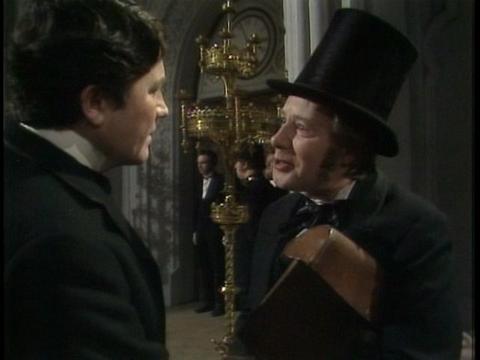
Phineas Finn (Donal McCann) and Mr Slide (Clifford Rose) at close, Slide threatening to expose Phineas
The subject of Pallisers 4:8 is centrally politics as is the subject of Trollope’s Phineas Finn. In Phineas Finn Trollope uses his story and characters to explore and dramatize (and gives us outright dialogues and letters when that’s not enough) his ideas about politics, what should be the ideal, how politics really works out in the public world, whether going into office corrupts a man too fully (Turnbull) or allows him to influence a result (Monk—this is also Thomas More’s position in Utopia); Trollope also canvasses specific issues and attitudes towards these (the secret ballot, getting rid of rotten boroughs, “purity” [no bribes] in elections, and tenant right in Ireland). Phineas is at the center of Episode 8 because he was at the center of Phineas Finn. Critics have long criticized Phineas Finn for having a character at the center who is not reflective and not anguished about joining the world (as say for example George Bertram is), but that’s precisely what Trollope wanted: someone who did buy into the world’s admiration for power, luxury, prestige, place, and someone who was also an outsider, no familial connections, and who had real sympathy for the powerless from where he came (the Irish).
This does jar with Raven who is not a believer in progress even palliative, and not much interested in it for the powerless in any case. So in his film he changes some of what Phineas says and does, even reversing it because his interest moves in a different direction. A key scene in Episode 8 shows us Phineas easily freeing Bunce because he’s a gentleman, can readily know how to flatter and quietly bribe; this is the opposite of what happens in the novel where Phineas has a hard time freeing Bunce. Trollope strongly believes the game though is worth the candle, and Raven (I feel) does not, for he sees little progress although he does admire the idealists (Monk) and ethical pragmatists (Palliser, Phineas, and the Duke of St Bungay).
The Part ends on Slide’s line in order to emphasize the price Phineas is going to pay as 4:7 ended on Clarkson’s nagging of Phineas for money Phineas never borrowed but was forced to sign for as a tit-for-tat favor for Fitzgibbon. 4:7 ends with an embodiment of politics as at core doing favors for others; 4:8 ends with an embodiment of the idea politics is amoral cutthroat fighting for individual power. This episode also shows us strongly the price Lady Laura Kennedy is now beginning to pay, and will continue to pay without the rewards Phineas eventually will know (of doing some good, of rising high in public life).
I now realize that not only was 4:7 a story about Phineas as beginner, it equally emphatically traces the decision of Lady Laura Standish to reject Phineas’s offer of marriage (which she knows is coming) in favor of marrying a man for money whom she does not love. Not all the scenes at Loughlinter are told from Phineas’s point of view: two key ones are between Robert Kennedy (Derek Godfrey) and Lady Laura, and there is one hinted at off-stage from which she emerges with a dark sombre face, having told Kennedy she will marry him. I would revise my title for 4:7 and call it the Beginners. Lady Laura was a beginner too, as Trollope’s Lady Laura tells us in Phineas Finn and Raven’s begins to in Pallisers 4:8, she has stumbled much worse than Finn at the outset, and for her as a woman, there is no going back to retrieve her position; she has misunderstood the possibilities of marriage for a woman, underestimated her love for Finn, and (a parallel to Kate Vavasour Karin MacCarthy] here), given up far too much in support of a brother.
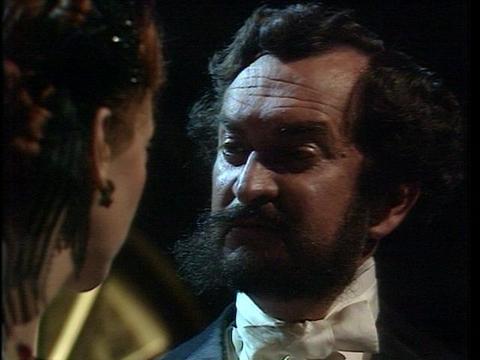
In 4:7, Robert Kennedy (Derek Godfrey) telling Lady Laura Standish (Anna Massey) it’s not Fate that makes things happen but God
Phineas is now in the thick of life (as is Lady Laura, only hers is a tomb), and 4:8 is characterized by a number of active scenes which stretch the capacities of the small TV screen: a crowd and mob scene, a man arrested in a crowd scene with a politician parading to press the flesh and also get into his carriage and get away; a fight to a near-death (it’s a close call) in the streets of London, as well as emphatic public scenes of debates in parliament. By contrast, what has happened to Lady Laura is closing down of activity, a cutting off from life’s possibilities because her husband insists on making her subservient to & live within his psychological life.
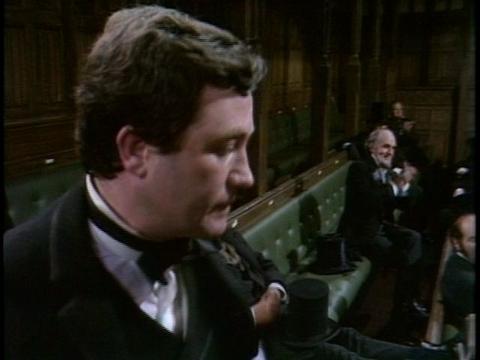
Phineas making an ass of himself but applauded by all including Turnbull (Edward Burnham)
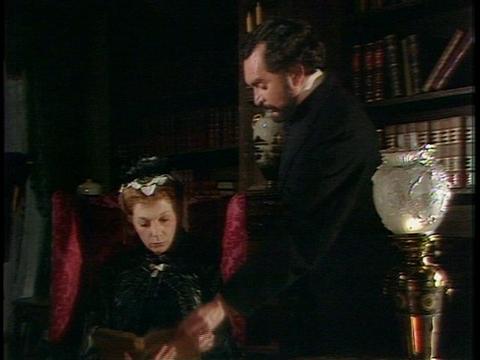
Now married, Kennedy taking novel away from Lady Laura: he forbids her to read it on Sunday, and then reads a sermon to her
We again (as we have had in all the series’ Parts) parallels as well as contrasts. While this woman’s fate contrasts tragically to “her” young man’s (Lady Laura’s to Phineas’s as a Telemachus who continually get a new chance; if one woman says no, there’s another; if he goofs one speech, there’s another as no one invests his activities with intense egocentric identification). Lady Laura is a parallel and contrast to 1) Lady Glencora (Susan Hampshire) who was married off against her will, also though for money and aggrandizement, but has had the luck to land (cat-like, women being as a character in A.S Byatt and Mary Astell, the 17th century feminist agree, set up to be stray kittens men can pick up) a good kind man, Plantagenet Palliser (Philip Latham), who while he would prefer himelf to study and read and see her immerse herself simply in his children, is also willing to let her lead a public life with him, helping him
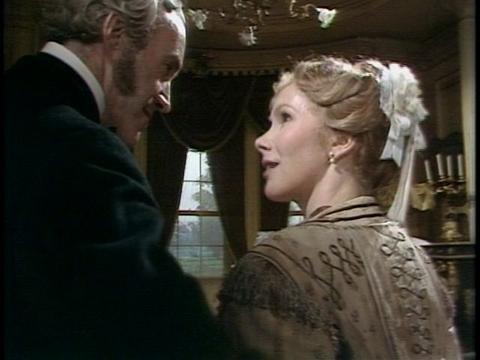
Plantagenet (Philip Latham) advising Lady Glencora Palliser (Susan Hampshire) not to overdo while she’s pregnant
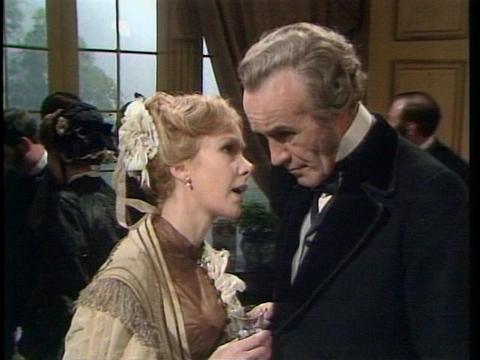
Palliser genuinely listening to Lady Glen (admittedly this is not common)
Lady Laura is also paralleled to 2) Violet Effingham (Mel Martin) who (unlike Trollope’s book) shows no strong independence or feminism or intense liking for Chiltern, but is nonetheless rightly afraid to cast any lot with him, given his violence, debts, unstable life of sheer animal pleasure for himself.
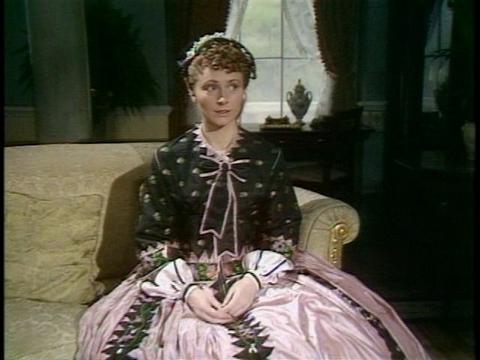
Violet Effingham (Mel Martin) looking very virginal: by contrast, Trollope’s Violet is an ironic witty woman not too young & reluctant to marry
It’s one thing for Phineas to enjoy his company; quite another for her. Whether he intended it or not, Raven presents a parable of women’s risks and lack of liberty contrasted to men’s opportunities and ability to try to act impersonally in the public sphere. Not that Phineas carries this off altogether: the way the newspaper man seeks to control him is to threaten to bring his private life into the public. But the parallel is no longer just about whether you marry for love or money; now we have a contrast to show what a dangerous leap in the dark it is for a women (reminding me of Charlotte Lucas’s speech in Austen’s P&P). The implicit contrast in 4:7 between Lady Laura and Kennedy and Lady Glen and Palliser becomes deadly bad news for Lady Laura: a death-in-life in private life, and less and less access to people outside her husband’s company.
Madame Max (Barbara Murray) appears only twice and as a sophisicated (worldly wise) free woman, endangered only if her private love life becomes public knowledge. Here is a parallel with Finn who as an outsider is also at greater risk than those with incomes: he must bounce (more than Bunce [Hayden Jones]) from rotten borough to rotten borough., and must vote to uphold what has put him in parliament though this is one of the reforms he fervently believes in on principles. She is also there to remind us of the Duke of Omnium (Roland Culver), now courting her, part of the Palliser more private material kept in stasis for later development.
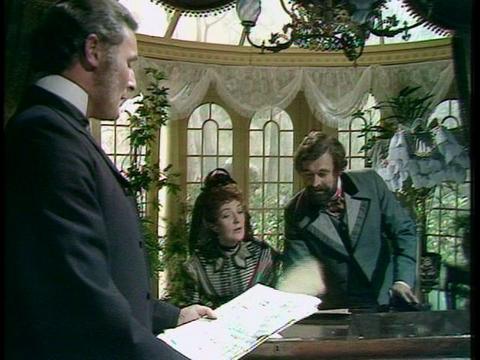
Madame Max (Barbara Murray), Dolly Longestaffe (Donald Pickering) and Barrington Erle (Moray Watson) sing from Much Ado About Nothing, “Men were ever deceivers …”
We do not see Mary Flood Jones (Maire Ni Ghrainne) in this part so there is no parallel between Madame Max and Mary Flood Jones (unexpected but actually an insightful one on Raven’s part, one Trollope overlooks); rather she seems a gentle supporter whenever she has a chance defending Phineas, and when she meets him (unlike Lady Laura who wants things from him) non-coercive in her hints he must keep a cheerful face and look about him for a new place when his is legislated out of existence.
Nonetheless, the episode is mostly politics; the love stories are threaded through. The opening scene occurs in the Parliament chamber, the scene about the Kennedys is also about Phineas’s failure to speeak, then we listen to talk just outside Parliamentary chambers in the corridors of power; the move to Phineas’s lodging where Mr Clarkson harasses him connects to politics as it was pressure from Fitzgibbon (Neil Stacy) who had introduced Phineas to parliamentary life which has led to this; and it is Mr Clarkson who (as he says in a second scene of harassment) tells Quintus Slide about Phineas’s doings. Between the first and second scenes with Clarkson we have Madame Max who also defends Phineas, and then time out for Phineas to save Chiltern (John Hallam) (which leads to gratitude by Lord Brentford [Lockwood West]). The high and mid-point of the Part weaves back and forth from the Parliamentary chamber where Turnbull (Edward Burnham) speaks and Phineas flubs a speech to the streets where we see crowd scenes, politicians coming in and out, and at the end Phineas and Monk (Byran Pringle) walking round to comment on what’s happening; Mrs Bunce (Brenda Cowling) waking Phineas at dawn and Phineas’s successful visit to a police station before dawn in the morning, where he ends up bribing the sergeant (Edwin Richfield) to free Bunce (the sergeant is not impressed by his assertion he’s a lawyer and knows and can wake judges). Then still at mid-point we have one of the long salon scenes of many dialogues about what’s happening politically which themselves reveal the working of electoral & public power politics. The last episode has Phineas saving Kennedy and now Brentford providing a new seat for Phineas, and then the penultimate scene is again a tumultuous parliament with Phineas at least an able speaker.
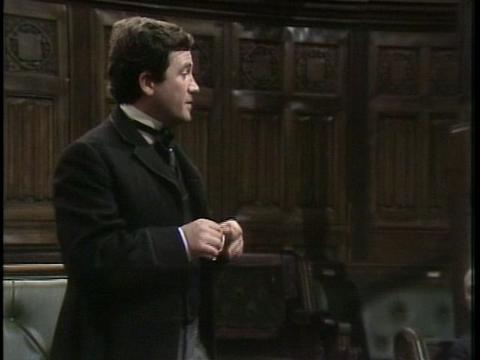
Phineas near end still of episode, succeeding in his defense of the government and Mr Monk
I think it important to notice that even though Phineas’s story is one of slow advancement and success both 4:7 and 4:8 end on bitter scenes: 4:7 with the debt collector harassing Phineas, and 4:8 with the newspaper man pressuring and threatening him with smut and slander and showing how he cannot act idealistically in life. It might be said that Raven and his team are showing the costs of politics to the average man (not superrich, not super-connected), but it’s significant that all but one part in 8 (3:6 when Palliser looks forward so gravely and earnestly to being Chancellor of Exchequer) of this 1974 Palliser series has ended in despair or dark ironies.
On the soap opera aesthetic or the Part’s relationship to the rest of the Phineas matter:
Pallisers 4:8 may be said in structural terms to correspond to Pallisers 2:3. Pallisers 1:1 drawn mostly from a couple of chapters in The Small House at Allington set the terms of the story: a coerced match; this was done mostly pictorially and symbolically, with some epitomizing dialogues and gesture scenes (between the two courting couples, Griselda, Lady Dumbello (Rachel Herbert) and the young Plantagenet Palliser (Philip Latham); Lady Glencora McCluskey and Burgo Fitzgerald [Susan Hampshire and Barry Justice]); Pallisers 1:2 introduced us more intimately to the secondary characters, the Vavasour group, through travel, the fleecing of George Vavasour (Gary Watson) in an campaign scene, and it kept before our eyes the basic clashes in the coerced match story (by repeating them in another theatrically pictorial scene in a fencing club). It was in the third episode, 2:3 (“The Splendours and Miseries of Courtesans”), when we visited Matching Priory that the story line began to develop in nuanced psychological earnest from the premises set up. 2:3-3:5 gives us a core version of CYFH? with new emphases, a different take and occasionally different enunciations (the event is dramatized differently from the source text). 3:6 was transition, coda for the shortish Vavasour novel, and shift in perspective for the Palliser matter, with a slowly developed introduction to Phineas Finn (Donal McCann), first in two scenes in epitomizing words, then in an appearance in the corridors of power, and finally a series of characteristic actions and reactions to him in the second great garden party of the series. (The first is in the opening of 1:1.)
As with the Palliser matter in Pallisers 1:1, the way the Phineas matter is introduced in 3:6 is through epitomizing statements and dramatic tableaux. Although I’ve not emphasized Lady Laura Standish (Anna Massey) in 3:, we are not allowed to see Phineas very much before we see his strong dependence on Lady Laura Standish, and her role as his mentor, and real erotic (physical and affectionate) attraction to him. Two of the five scenes of 3.6, Episode 30, “The Christening” reveal Phineas’s inner life and aspirations in dialogues with Lady Laura.
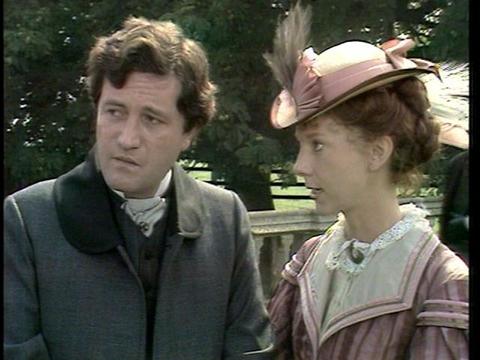
From 3:6, Phineas and Lady Laura Standish (Anna Massey) at the Christinening, she acting as his Mentor
So while the 26 parts of the series still falls into 4 large novels and 3 small novellas, with the matter of the second centered on Phineas, the Laura story is important thematically and structurally to the first half of this Phineas matter, which corresponds to Phineas Finn. I have yet to study the second half (which comes after the Lizzie Eustace and Lord Fawn story [Derek Jacobi & Susan Badel], the third novel, an adapation of The Eustace Diamonds), which second half corresponds to Phineas Redux.
Sylvia
--
Posted by: Ellen
* * *
Comment
commenting closed for this article
